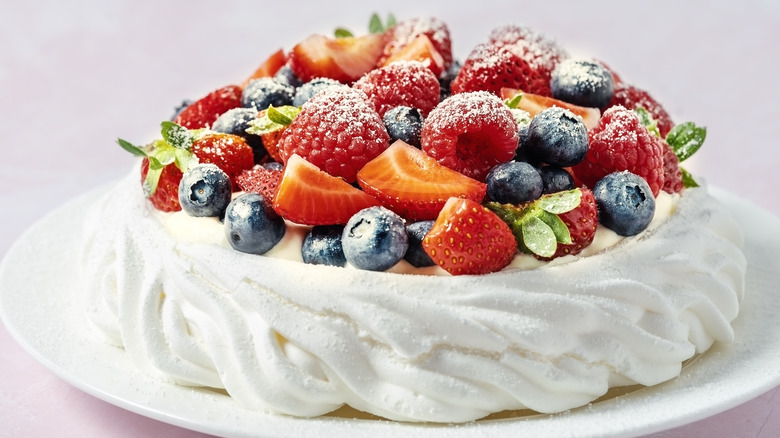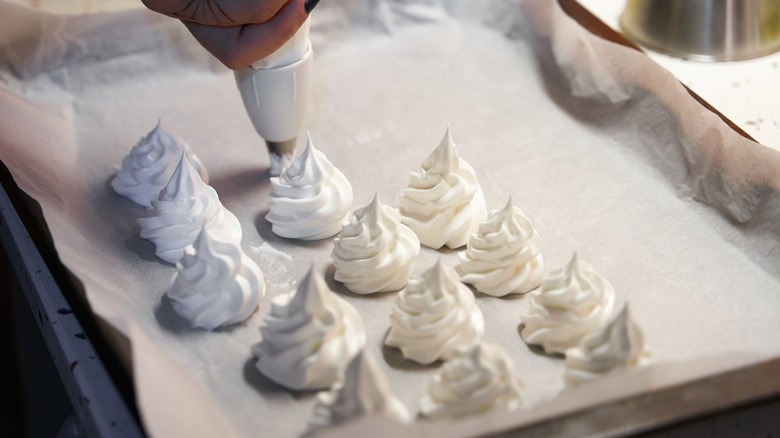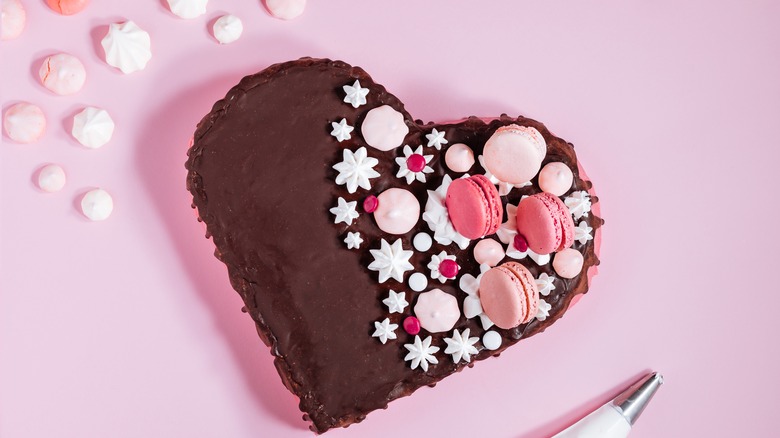The Textural Difference Between Pavlova And Meringue
The primary ingredient in both a pavlova and a meringue is egg whites, and the two desserts actually look and taste fairly similar when they are finished. However, a meringue is crunchy throughout, and it easily breaks down into delicate, fine crumbs — although some meringue variations can also be delightfully chewy. On the other hand, a pavlova is crisp on the outside with a soft and marshmallowy center. This textural distinction comes from slightly different ingredient additions, and how each treat is cooked.
Meringues are usually made by simply beating egg whites and sugar together until the mixture forms stiff peaks. As the sugar is gradually added during whipping, the texture thickens and the sheen turns glossy — this is a French meringue. It is often piped into pointy-peaked cookies or piled on top of pies or tarts and then torched or broiled, in which case, cream of tartar is typically added for stability.
A pavlova starts in exactly the same way, so it is technically made with a French meringue base. After the mixture is beaten, cornstarch and either lemon juice, vinegar, or cream of tartar is added in. Any of these acids promote stability. Cornstarch helps maintain the soft consistency, reinforces the structure, and absorbs liquid that may seep out from the egg whites. Before cooking, a pavlova is typically spread out into a cake-shaped round.
Cooking methods for pavlovas and meringues
The pillowy inner texture of a pavlova is created thanks to these extra ingredients, as well as a cooking method different from making meringue. Pavlova is cooked at around 300 degrees Fahrenheit — at least for the beginning of the baking period — for about an hour. Traditionally, meringues are baked at around 200 degrees Fahrenheit for much longer — closer to three hours. This lets the cookies dry out completely, and creates an airy texture without introducing any browning, so they stay light and white. It is also common for recipes to call for turning off the heat and allowing the cookies to slowly cool inside the oven.
There are many different recipe variations with methods that blur the line between these two sweet treats. For example, some pavlova recipes call for a longer cooking time at a lower heat, and some meringue cookie recipes require a stabilizer like cream of tartar, along with a higher cooking temperature and a shorter bake time.
Additionally, the other two types of meringues — Swiss and Italian — are gently cooked, but not baked. Instead of incorporating granulated sugar into the whipped egg whites, Italian meringue calls for streaming in hot sugar syrup, which partially cooks the eggs. Swiss meringue is gently heated as the egg whites and sugar are whipped in a double boiler. Both these varieties are more stable than French meringue, so they are often used as components in other desserts, like frosting for an ice-cream cake.
How to serve pavlovas and meringues
Pavlovas are often served as a centerpiece dessert piled high with whipped cream and fruit. Multiple rounds can even be stacked to make a cake-like dish. Because a pavlova is pretty delicate, small cracks and irregularities are quite normal. In fact, the variations make this a rustically beautiful dessert, and provide plenty of nooks and crannies for the toppings to soak into.
Australians and New Zealanders happen to be particularly enthusiastic fans of this dessert, with both Antipodean nations claiming its invention — pavlova caused a literal feud between the two countries. There are many versions, and a pavlova is one of the traditional dishes following Christmas dinner in both places.
Meringue cookies are an impressive dessert in their own right, because they can be so challenging to perfect. Classically, they are vanilla-scented and white in color, though various extracts can be used as flavorings. The meringues are often given pastel tints with food coloring, and dainty stripes are common. They are usually served as part of a pretty cookie display, or as a delicate decoration on cakes and other desserts. You could even adorn a fruit-topped pavlova with a few meringue cookies for a picture-perfect finish!



